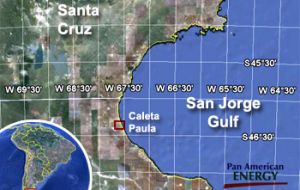MercoPress. South Atlantic News Agency
Argentina: Oil Co. report refutes drop in hake stocks
 The findings of studies undertaken by Pan American Energy in the San Jorge Gulf fail to reveal problems with hake biomass.
The findings of studies undertaken by Pan American Energy in the San Jorge Gulf fail to reveal problems with hake biomass. An investigation carried out by the oil company Pan American Energy (PAE), at the behest of the Santa Cruz Fisheries Subsecretariat, contends that the capture of common hake (Merluccius hubbsi) has spiked in the San Jorge Gulf fishing-ground. The results of the study contradict claims by the yellow fleet fishers of Caleta Paula, who complain of a smaller abundance of the resource.
The fishing sector maintains that the submarine seismic survey conducted by the company spurred a fall in the hake volume.
“The Subsecretariat of Fisheries of Santa Cruz requested a specific measure from us as far as the gulf; that we conduct a fisheries monitoring before, during and subsequent to the survey. We did so in 10 stations and compared it to the seismic one we did within the ban zone,” explained Fernando Villarreal, vice-president of Offshore Operations of Pan American Energy.
“We measured biomass, biodiversity and other physical parameters like temperature and the salinity of the water,” he continued.
Those studies were conducted by scientists of the company Ezcurra & Schmidt SA - hired by Pan American – and supervised by a Santa Cruz inspector.
The company submitted a report to the provincial government in which it detailed the results of environmental monitoring carried out over the last three years in the fishing-ground of San Jorge Gulf.
The document specifies that fishing “increased” in size and quantity in the zone over the last year and that the Caleta Paula port was one of the beneficiaries with a 45 per cent growth in 2009.
The 211-page report details the actions conducted in the three surveys carried out between the months of August to October 2009 in the San Jorge Gulf.
The seismic survey project consisted of the study of 1652 square kilometres by means of the 3D marine seismic technique, within the area located in the central zone of San Jorge Gulf, in the jurisdictions of the Chubut and Santa Cruz provinces.
The zone of study was set between parallels 46º 00' and 46º 16' South and meridians 66º 40' and 67º 30' West.
During the campaigns, fishing nets were used from commercial fishing vessels that normally operate in the area of:
• Campaign I (Stage prior) was carried out on days 11 to 14 August 2009;
• Campaign II (Stage during) was carried out on days 24 to 28 September 2009;
• Campaign III (Stage post) was undertaken from 24 to 26 October 2009.
•
The research was carried out onboard the seismic ship Western Patriot.
According to research findings, a noticeable predominance of common hake was observed over the rest of the species present.
In the case of Campaign I, hake hubbsi represented 86 per cent, and in Campaigns II and III, 96 per cent of the total. The average sizes of the resource are similar in the three campaigns, with a small variation.
In terms of water quality, the researchers assured that physical, chemical and sedimentological parameters did not vary during the study.
In addition, all the values of temperature and salinity are characteristic of gulf waters.
In relation to the landings registered in Caleta Paula port, the document specifies that 45 per cent more hake was landed in 2009 than in 2008.
According to Subsecretariat of Fisheries and Aquaculture statistics, 274,051.2 tonnes of hake were landed between 1 January and 31 December in Argentine ports, 4 per cent more than in 2008, when 263,322.5 tonnes were unloaded.
Over the last year, the terminal of Caleta Paula received 11,242.4 tonnes of hake; whereas it registered 7,692. 9 tonnes in 2008.
Meanwhile, Santa Cruz governor, Daniel Peralta announced that the findings of a survey conducted by the National Institute for Fisheries Research and Development (INIDEP) will be revealed in a couple of weeks.
The authorities and the fishing industry of the Patagonia province hope the INIDEP reveals that the decrease of the resource is due to “a biological question” or another factor. (FIS)




Top Comments
Disclaimer & comment rules-

-

Read all commentsThe Wolf Tones - Admiral William Brown
Feb 13th, 2010 - 12:58 pm 0What is British Petroleum doing looking at fish production?
Feb 13th, 2010 - 01:26 pm 0Commenting for this story is now closed.
If you have a Facebook account, become a fan and comment on our Facebook Page!